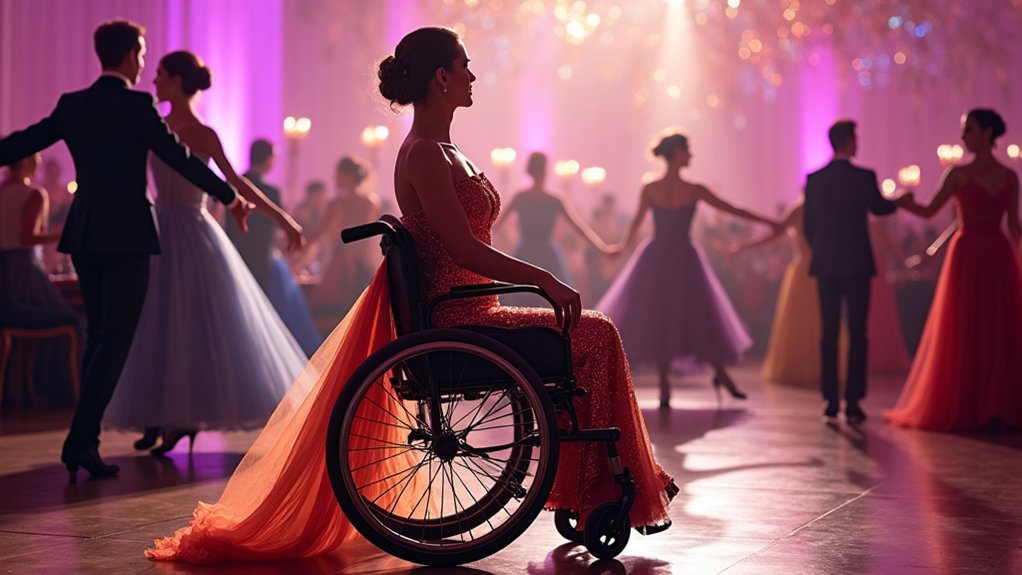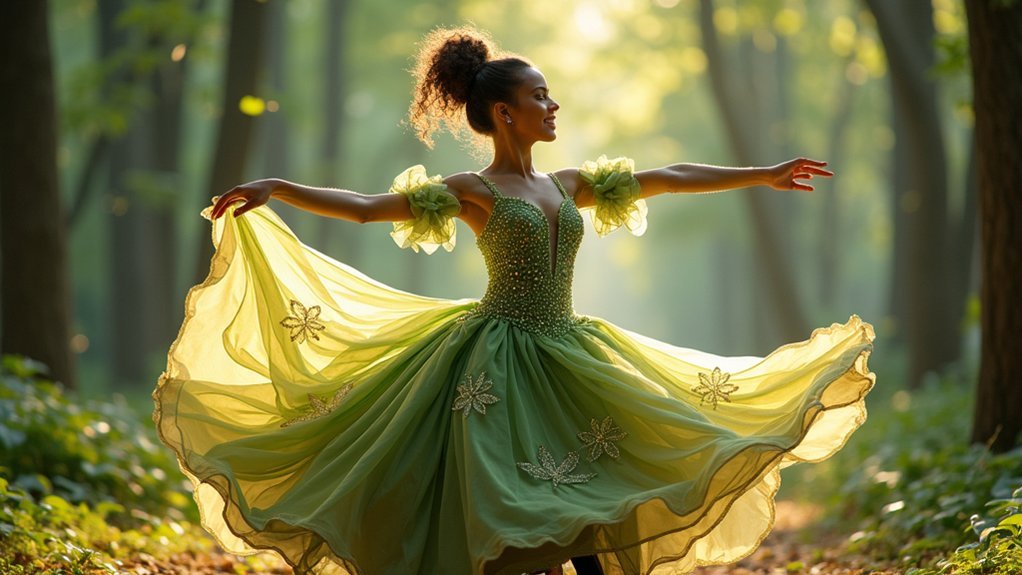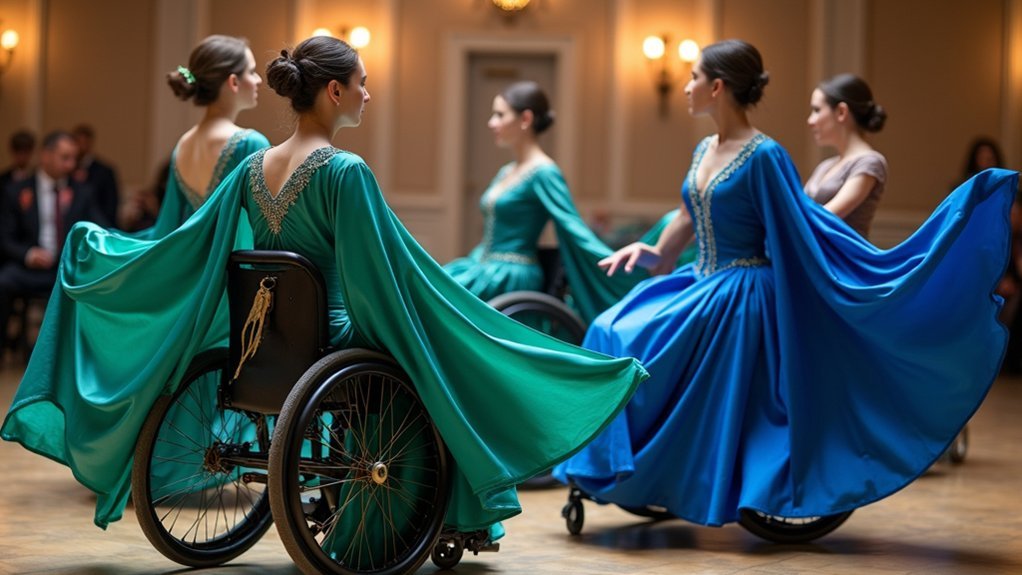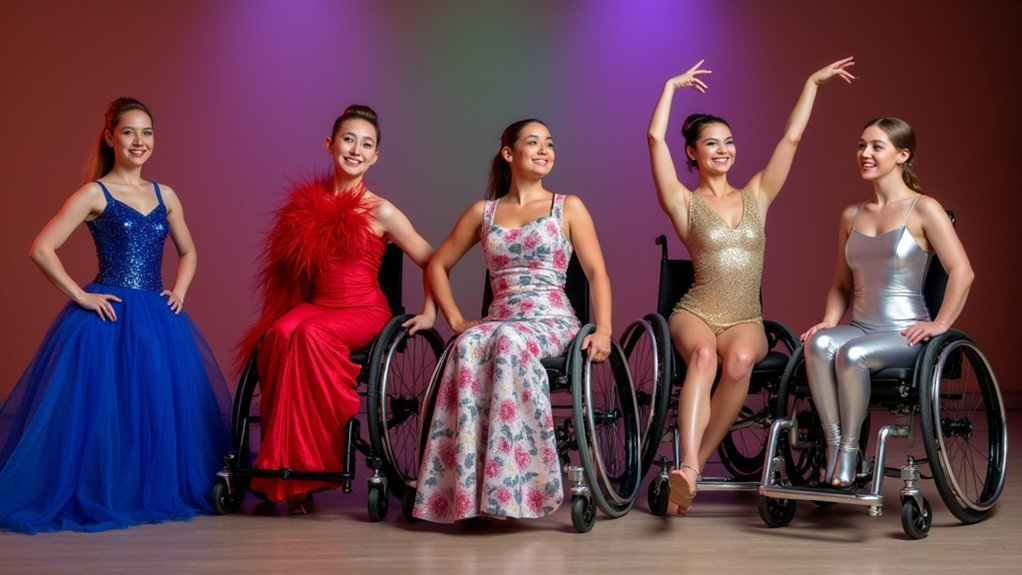Wheelchair dancers can shine with these stunning costume ideas: transform your chair with ballroom elegance using decorative covers; create visual magic with LED-enhanced outfits that sync to music; express fluid movement through nature-inspired ensembles with flowing fabrics; showcase favorite characters with pop culture wear featuring reflective materials; or celebrate tradition with adapted historical dance costumes. Each design treats your wheelchair as an integral part of your artistic expression. Discover how these concepts can elevate your next performance.
Ballroom Elegance: Transforming Wheelchairs Into Dance Floors

While many view wheelchairs primarily as mobility aids, ballroom dancers have reimagined them as dynamic dance partners and elegant performance platforms.
You can enhance your chair’s visual integration with costumes by adding decorative covers or elements that complement your attire.
Consider lightweight adaptations that won’t interfere with your chair’s specialized features like cambered wheels and anti-tip supports. Seek materials that create visual flow during movement—fabrics that drape elegantly around your chair’s frame without catching in wheels.
Elegance meets functionality when fabrics flow harmoniously with your chair’s movement while respecting its essential support features.
For competitions, customize your wheelchair to match your partner’s costume through color coordination and thematic accessories. Many dancers add LED lights, fabric panels, or metallic accents to transform chairs into stunning visual elements. Para dancers often compete in various styles including International Standard, Latin, and freestyle, each requiring different aesthetic considerations.
Light-Up Spectaculars: Creating Visual Magic in Motion
As the stage lights dim, LED-enhanced costumes transform wheelchair dancers into mesmerizing light sculptures that captivate audiences. You’ll find that RGB LEDs, EL sheets, and LED tubes offer endless creative possibilities while remaining comfortable and movement-friendly. These designs are perfect for creating the kind of stunning visual graphics that have made Tron dance acts so effective for business promotions.
| Technology | Performance Feature | Dancer Benefit |
|---|---|---|
| Sound-reactive LEDs | Synchronizes with music | Enhances rhythmic expression |
| Remote-controlled systems | Changes patterns mid-performance | Allows seamless shifts |
| Wheelchair-integrated lights | Incorporates mobility device as art | Creates unified visual identity |
| Programmable sequences | Coordinates group choreography | Builds cohesive ensemble effects |
| Rechargeable batteries | Powers 2-5 hours of performance | Provides reliable show duration |
Consider waterproof options for durability during active performances. With personalized lighting displays reflecting your artistic vision, you’ll create multi-sensory experiences that emphasize the unique kinetic qualities of wheelchair dance while ensuring technology serves your creative expression.
Nature-Inspired Ensembles for Fluid Movement Expression

Nature’s boundless movement patterns provide perfect inspiration for wheelchair dancers seeking to express fluidity and grace. Incorporate flowing fabrics with floral patterns or leaf motifs that accentuate your movements as you glide across the stage.
Blues and greens evoke water’s natural flow, while lightweight materials create dramatic visual effects with each turn.
Transform your wheelchair into part of your artistic expression by adding decorative elements like flower garlands or colored fabric strips that complement your costume. Prioritizing comfort and mobility ensures dancers can perform with confidence while expressing their artistic vision.
Consider mesh overlays and transparent elements to enhance the sense of lightness and freedom in your performance.
Accessorize thoughtfully with floral crowns, leaf-shaped jewelry, or feather details that reinforce the nature theme while ensuring your modified chair remains streamlined for ideal maneuverability during those fluid, innovative choreographed movements.
Pop Culture Performance Wear With Wheelchair Integration
Pop culture characters offer wheelchair dancers exciting opportunities to transform performances into recognizable, dynamic tributes to beloved icons. By incorporating your wheelchair’s frame as an integral structure, you’ll create stunning costumes like Spider-Man, Buzz Lightyear, or transform your chair into a pirate ship or spaceship.
Choose materials that enhance your performance impact:
- Lightweight, flexible fabrics that allow fluid upper-body movement
- Sequins and reflective materials that catch stage lighting
- LED lights or sound elements for immersive storytelling
These adaptations don’t just look impressive—they challenge stereotypes by presenting wheelchair integration as a transformative artistic device.
With attachable props using velcro and removable extensions, you’ll maintain character detail while ensuring mobility remains uncompromised, extending your expressive range during performances. Organizations like Magic Wheelchair have pioneered innovative designs that combine aesthetic appeal with practical functionality for performers.
Historical Dance Costumes With Modern Adaptive Features

Historical dance costumes offer wheelchair dancers a rich palette of inspiration that bridges traditional artistry with contemporary adaptive needs.
You’ll find elements from Cotswold morris traditions—like decorative arm bands and baldrics—that can be beautifully adapted for wheelchair performances.
Consider incorporating colorful ribbons, belts, and frilled aprons from folk dance traditions while using modern lightweight materials like spandex and nylon.
These fabrics provide durability without restricting movement. Your costume can seamlessly integrate with your chair, treating it as part of the performance rather than separate from it.
Look to historical figures like Peg Leg Bates for inspiration on adaptive techniques.
Integrated dance groups that emerged in the 1970s demonstrated how challenging ableist traditions can transform the dance landscape for performers with disabilities.
With adjustable fits and easy-removal features, you’ll maintain both authenticity and functionality while creating visually striking patterns that redefine traditional dance aesthetics through your unique movements.
Frequently Asked Questions
How Can Dancers Maintain Safe Temperature Regulation in Elaborate Costumes?
You’ll maintain safe temperature regulation in elaborate costumes by choosing breathable fabrics, incorporating removable layers, staying hydrated, using cooling accessories, and testing costumes in varied conditions before performances.
What Waterproofing Methods Protect Electrical Components in Light-Up Costumes?
For light-up costume electronics, you’ll want to use conformal coatings like silicone or acrylic, potting with epoxy resin for complete protection, or double housing designs with breathable membranes to prevent moisture damage while maintaining flexibility.
How Do Wheelchair Dancers Navigate Quick Costume Changes Between Performances?
You’ll navigate quick costume changes using adaptive designs with easy-access closures, modular pieces, and designated assistants. Pre-organize your costumes, practice shifts, and utilize wheelchair-specific modifications like removable armrests for seamless between-performance changes.
What Budget-Friendly Alternatives Exist for Specialty Adaptive Fabrics?
You’ll find several budget-friendly alternatives to specialty adaptive fabrics: repurposed clothing, cotton-polyester blends, secondhand textiles, remnant fabrics from stores, and community donations. Try embellishing with household items or foam for structure and uniqueness.
How Can Partners Coordinate Costumes While Maintaining Wheelchair Accessibility?
You can coordinate with matching color schemes and complementary accents while prioritizing mobility. Use hook-and-loop fasteners, choose snag-free fabrics, and test movements together during fittings to guarantee both style and accessibility remain balanced.
In Summary
When you embrace these costume ideas, you’re not just dressing up—you’re transforming your performance space. Your wheelchair becomes an integral part of your artistic expression, not an afterthought. Don’t limit your creative vision! With thoughtful design and personal flair, you’ll captivate audiences while dancing comfortably. Remember, the best costumes highlight both your movements and your unique presence on the dance floor.





Leave a Reply